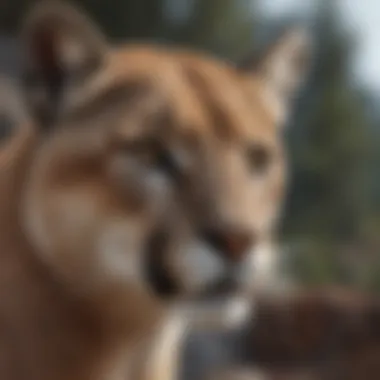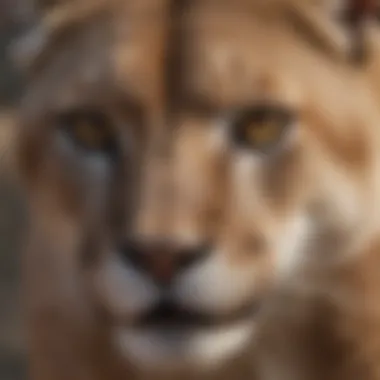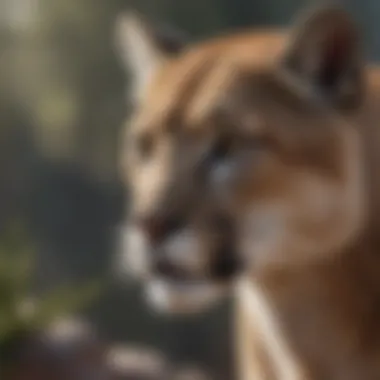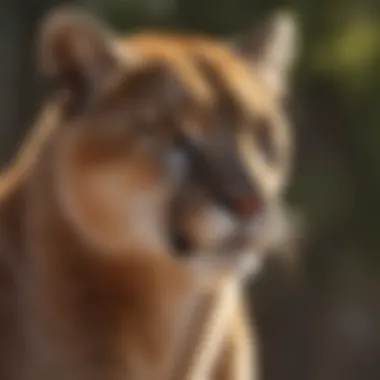Unveiling the Enigmatic Beauty of Mountain Lions


Nature Topic Overview
In this detailed exposition on the enigmatic world of mountain lions, or commonly referred to as cougars, we unravel the intricate physical characteristics that define these fascinating predators. From their striking tawny coat glistening under the sun to their robust and sinewy musculature that speaks of pure power and agility, our exploration will transcend mere visuals to provide an in-depth understanding of what makes these majestic creatures such efficient hunters.
Fun Facts and Trivia
Discovering the hidden gems of mountain lions can be not only educational but also entertaining for young minds. Did you know that cougars can leap up to 5.5 meters in one bound, showcasing their remarkable athleticism? Introducing interactive elements such as quizzes and visuals depicting the raw beauty of these creatures will enrich the learning experience, captivating the curiosity of our young readers and inspiring a deeper appreciation for wildlife.
Wildlife Explorations
Venturing beyond the realm of mountain lions, our wildlife exploration delves into the diverse species intertwined with their habitat. From exploring the symbiotic relationships between cougars and other animals to unveiling the plant species that coexist in their environment, this section aims to unravel the interconnected web of life within the mountain lion's domain. Engaging elements like puzzles and wildlife trivia will not only educate but also enchant readers of all ages, fostering a deeper connection with the natural world.
Environmental Awareness
As we probe into the mysteries of mountain lions, our journey extends toward the vital importance of conservation and sustainability in preserving their habitat. Shedding light on the impact of human activities on wildlife and habitats, we discuss actionable tips for young conservationists to make a difference. By instilling a sense of environmental consciousness and offering practical guidance on protecting nature, we empower our readers to become stewards of the earth's precious ecosystems.
DIY Nature Activities
Empowering young explorers with hands-on activities, our DIY nature segment brings the wonders of the outdoors into their homes. Through step-by-step guides on crafting nature-inspired projects or stimulating outdoor excursions, children can apply their newfound knowledge in a fun and interactive manner. Encouraging creativity and scientific curiosity, this section ignites a passion for nature in the hearts of our young audience, nurturing a generation of nature enthusiasts and environmental advocates.
Introduction
The domain of mountain lions, also famously referenced as cougars, is a realm shrouded in enigma and allure. These majestic predators, with their enigmatic aura and formidable presence, command both fascination and respect from wildlife enthusiasts and observers worldwide. The debut of this article ushers you into a riveting exploration of the physical features and behavioral intricacies that characterize this enigmatic species. By delving into the intricate details of mountain lions' appearance and behavior, readers embark on a journey that unravels the mystique surrounding these exceptional creatures.
Overview of Mountain Lions
Within the expanse of wildlife taxonomy, the mountain lion occupies a distinguished position as a predator of remarkable prowess and adaptability. As elusive inhabitants of diverse ecosystems spanning North and South America, mountain lions exhibit a fascinating array of characteristics that set them apart from their counterparts in the animal kingdom. From their silent strides through verdant forests to their agile maneuvers across rugged mountain terrains, the mountain lion epitomizes grace and power in its purest form.
Significance of Understanding Mountain Lion Appearance


The comprehension of mountain lion appearance transcends mere physical observations; it delves into the very essence of ecological balance and biodiversity conservation. By dissecting the nuances of their tawny coat, muscular physique, and distinctive facial features, observers gain profound insights into the evolutionary adaptations that have sharpened the mountain lion's predatory prowess over millennia. An in-depth understanding of the visual manifestations of these apex predators equips conservationists, researchers, and wildlife enthusiasts with invaluable knowledge essential for ensuring the preservation of these magnificent creatures for generations to come.
Physical Characteristics
Physical characteristics are crucial when studying mountain lions, as they offer valuable insights into the makeup of these magnificent predators. A deep understanding of their coat color, body structure, facial features, size, and weight provides a comprehensive overview of their anatomy and physiology, shedding light on their uniqueness and adaptability to their environment.
Coat Color
Understanding the coat color of mountain lions delves into more than just aesthetics. The tawny with black tips coat, for example, plays a significant role in their camouflage and survival in various habitats. The blend of tawny fur with black tips not only provides them with a distinct appearance but also aids in concealing them during hunts, serving as a protective mechanism against potential threats. This color variation showcases nature's exceptional design in equipping these predators with the tools needed for their existence.
Variations in Color
Exploring the variations in color among mountain lions reveals a spectrum of hues that offer insights into their genetic diversity and adaptability. From lighter shades to darker tones, these color variations can be influenced by factors such as geographical location and environmental conditions. Each variation presents a unique advantage, whether in enhancing camouflage in specific terrains or displaying individuality within the species. Understanding these color nuances adds depth to our perception of these elusive creatures and highlights the intricate balance between adaptation and genetic traits.
Muscular Build
The muscular build of mountain lions speaks volumes about their physical prowess and hunting capabilities. With powerful muscles distributed across their bodies, these predators exhibit exceptional strength and agility, enabling them to navigate rugged terrains with ease and pursue prey with precision. The lean yet robust build of mountain lions reflects their evolutionary specialization as apex predators, optimized for efficient movement and endurance in their natural habitats.
Long Tail
The long tail of mountain lions serves as a multifunctional tool that aids in their balance, communication, and hunting strategies. Its length provides stability during high-speed pursuits and assists in making sudden turns without losing momentum. Furthermore, the tail serves as a visual cue for communication among conspecifics, conveying messages through nuanced movements. This distinctive feature highlights the adaptability and evolutionary significance of the mountain lion's tail in its daily interactions and survival strategies.
Powerful Limbs
The powerful limbs of mountain lions form the foundation of their predatory skills, granting them the ability to leap great distances and overpower prey effortlessly. These muscular limbs are designed for agility and strength, allowing mountain lions to execute swift maneuvers during pursuits and engage in successful hunting tactics. Through their powerful limbs, these predators exhibit a blend of grace and power that exemplifies their mastery of the hunting craft in diverse landscapes and challenging terrains.
Facial Features
The facial features of mountain lions, particularly their prominent whiskers and distinctive muzzle, play essential roles in their sensory perception and communication. The long whiskers aid in detecting subtle movements and assessing spatial dimensions, giving mountain lions a heightened sense of their surroundings. Additionally, the distinctive muzzle structure contributes to their unique facial expressions and vocalizations, facilitating complex social interactions and territorial communications within their communities. These facial features exemplify the intricate adaptation of mountain lions to their ecological niche and underscore the importance of non-verbal cues in their behavioral dynamics.


Size and Weight
Exploring the size and weight variations among mountain lions provides insights into their physical development and reproductive biology. Adult measurements showcase the diversity in body sizes within the species, with males typically larger than females to support their roles as primary defenders and providers. Gender disparities in size and weight reflect distinct evolutionary strategies for survival and reproduction, where each sex's physical attributes are finely tuned to fulfill their respective ecological functions. Understanding these variations offers a glimpse into the nuanced dynamics of mountain lion populations and sheds light on the interconnectedness of size, weight, and behavioral adaptations in their evolutionary success.
Behavioral Aspects
The Behavioral Aspects section of this article plays a crucial role in shedding light on the intricacies of mountain lions' behavior. By delving into their hunting techniques and territorial behavior, readers can gain a comprehensive understanding of how these majestic predators navigate their environment. Understanding the Behavioral Aspects of mountain lions provides valuable insights into their survival strategies and interactions within their ecosystem, offering a glimpse into the fascinating world of these apex predators.
Hunting Techniques
Stalking Prey
Stalking Prey is a fundamental aspect of a mountain lion's hunting technique, essential for stealthily approaching their target. This method showcases the cat's exceptional patience and agility, allowing them to get as close as possible before launching an attack. The key characteristic of Stalking Prey lies in its silence and precision, enabling the mountain lion to secure a successful hunt without alerting its prey. This method is popular among mountain lions due to its effectiveness in ensuring a higher chance of catching their target by surprise. Stalking Prey's unique feature lies in its ability to capitalize on the element of surprise, giving mountain lions an edge in the competitive world of hunting.
Ambush Strategies
Ambush Strategies offer mountain lions a tactical approach to capturing prey by waiting in concealment for the perfect moment to strike. This method is pivotal in ensuring a successful hunt by utilizing the element of surprise and quick reflexes to overpower their target. The key characteristic of Ambush Strategies is their efficiency in conserving energy while maximizing the chances of a successful hunt. Mountain lions favor this technique for its effectiveness in securing a meal without engaging in prolonged chases. The unique feature of Ambush Strategies lies in their adaptability to different terrains and their ability to catch prey off guard, highlighting their prowess in using strategic planning to secure a meal.
Territorial Behavior
Territorial Behavior is a critical aspect of a mountain lion's lifestyle, essential for defining their space and interactions with other individuals. By exploring Marking Territory and Interaction with Other Cougars, readers can grasp the significance of territoriality among mountain lions. Marking Territory allows individuals to establish and defend their boundaries, warding off potential rivals and asserting dominance. Interaction with Other Cougars showcases the complex social dynamics within mountain lion communities, highlighting cooperation and competition for resources. Understanding the unique features of these behaviors provides insights into the advantages and disadvantages of territoriality among mountain lions, offering a comprehensive picture of their social structure and survival strategies.
Habitat and Distribution
In the grand tapestry of understanding mountain lions, exploring their habitat and distribution plays a vital role. The intricate relationship between these majestic predators and their environment unveils a tale of adaptation and survival. By delving into the specifics of where mountain lions choose to reside, we gain valuable insights into their behavior and lifestyle. Habitat and distribution are not merely geographical settings but the very essence of a mountain lion's existence, shaping their daily challenges and triumphs.
Preferred Habitats
- Mountainous Regions: Within the rugged beauty of mountainous regions, mountain lions find their sanctuary. The towering peaks, dense forests, and rocky terrain of these areas provide a perfect blend of camouflage, hunting grounds, and shelter. Their nimble agility is accentuated in the challenging landscape, allowing them to navigate steep cliffs and rocky outcrops with ease. The seclusion and abundance of prey in mountainous regions make them an ideal habitat for these graceful predators. Despite the harsh conditions, mountain lions thrive in these regions, showcasing nature's remarkable balance.
- Forest Environments: Among the whispering trees and dappled sunlight of forest environments, mountain lions find a haven teeming with life. The dense canopy offers protection from aerial threats, while the undergrowth conceals their movements, making them elusive shadows in the woodland. Forest environments provide a rich tapestry of biodiversity for mountain lions to explore, with ample food sources and opportunities for stealthy pursuits. The symphony of life in the forest envelops these powerful creatures in a world of instinct and adaptation, where survival is a finely tuned art.


Global Range
- North and South America: Across the vast continents of North and South America, mountain lions prowl with silent grace, embodying the spirit of the wild. From the snow-capped peaks of the Rockies to the lush jungles of the Amazon, these creatures traverse diverse landscapes with ease. The varied ecosystems spanning North and South America offer mountain lions a smorgasbord of environments to conquer and conquer they do, adapting to the challenges of each region with precision and finesse.
- Adaptation to Different Climates: One of the most remarkable aspects of mountain lions is their adaptation to different climates. Whether in the blistering heat of the deserts or the icy chill of the mountains, these resilient predators adjust their behaviors and physical attributes to thrive. Their fur insulates them from the harsh cold, while their sinewy muscles enable them to endure long periods without food. The ability of mountain lions to adapt to diverse climates underscores their flexible nature and evolutionary prowess, making them true masters of survival.
Interaction with Humans
Understanding the interaction between mountain lions and humans is crucial in shaping coexistence efforts. This section delves into the multiple facets of encounters between these majestic predators and human populations, aiming to educate readers on safety measures and conservation strategies.
Encounters in the Wild
Precautionary Measures
The implementation of precautionary measures forms a vital component of ensuring safety in areas where humans and mountain lions may cross paths. By outlining specific guidelines for hikers, campers, and residents in cougar territories, these measures serve as proactive steps to minimize potential conflicts. Highlighting the importance of staying vigilant and aware of surroundings, precautionary measures emphasize the need for respecting wildlife boundaries while enjoying the natural beauty of mountain lion habitats.
Coexistence Efforts
Coexistence efforts focus on fostering a harmonious relationship between humans and mountain lions. By promoting awareness campaigns, habitat preservation, and responsible waste management, these initiatives aim to reduce human-wildlife conflicts and protect both communities. Emphasizing the significance of mutual respect and understanding, coexistence efforts advocate for sustainable practices that benefit the ecosystem and its inhabitants.
Conservation and Management
Protective Measures
Implementing protective measures is critical in safeguarding both mountain lions and human interests. By establishing wildlife corridors, conservation areas, and wildlife-friendly fencing, protective measures help mitigate risks associated with human encroachment on cougar territories. This proactive approach underscores the importance of preserving natural habitats and creating safe spaces for these apex predators to thrive.
Human-Wildlife Conflict Resolution
Efficient conflict resolution between humans and wildlife is essential for maintaining ecological balance. By employing strategies such as non-lethal deterrents, habitat enrichment, and community engagements, conflict resolution initiatives strive to address issues arising from interactions between mountain lions and human activities. Promoting cohabitation through dialogue and innovative solutions, these efforts seek to prevent conflicts and promote a sustainable environment where both species can coexist peacefully.
Conclusion
In delving deep into the intricate world of mountain lions, also commonly known as cougars, it becomes abundantly clear that these majestic predators embody a blend of power, grace, and adaptability within their ecosystem. The elucidation of various facets of mountain lion appearance opens doors to a realm where nature's ingenuity is vividly displayed through their physical attributes. Through this exploration, we not only unravel the enigma surrounding their tawny coats and distinctive features but also gain a profound appreciation for the intricate web of life in which they are integral players.
As we meander through the wilderness of knowledge, diving into the recapitulation of mountain lion appearance, we are met with a striking realization of the meticulous design that characterizes these cunning predators. From the nuances of their muscular build to the alluring elegance of their long tails, every element strikes a chord in unison, harmonizing to create a symphony of functionality in the wild. The variations in coat color, from the subtle nuances of tawny hues with black tips to the innate ability to blend seamlessly into their surroundings, reflect an evolutionary marvel that has stood the test of time.
Appreciating nature's magnificent predators goes beyond mere acknowledgment; it transcends into a realm of reverence and respect for the intricate balance they uphold in the ecosystem. The demeanor of mountain lions, their poise in the face of adversity, and the sheer majesty with which they navigate their domains evoke a sense of wonder and awe. As we traverse the realms of understanding their hunting techniques, territorial behavior, and interaction with other cougars, we are beckoned to witness the complexities of nature's tapestry, woven with threads of survival, adaptation, and resilience. Engaging in this appreciation instills within us a profound sense of interconnectedness with the natural world, underscoring the importance of coexistence and conservation efforts in preserving these splendid creatures for generations to come.







